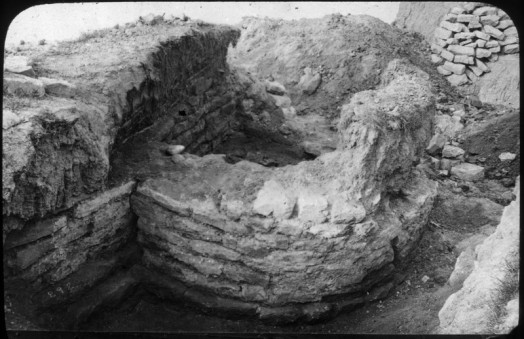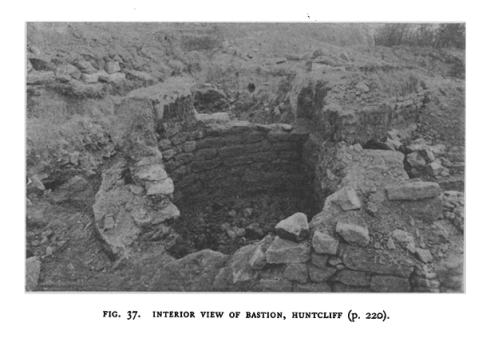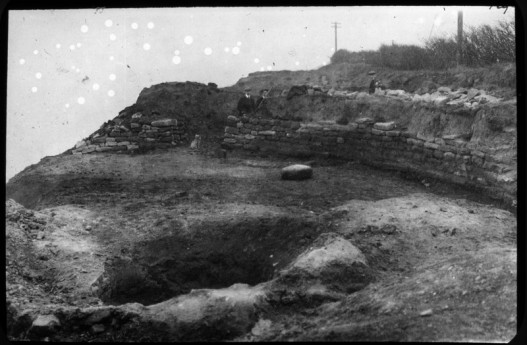Looking through the HEIR database, tagger Boarshill commented on this image:
He writes: ‘Huntcliff was a Roman signal station on the Cleveland Way coastal path a mile or two east of Saltburn-by-the-Sea. It was on cliffs (Hunt Cliff) which are eroding into the North Sea. Its brief story seems to be: first identified 1862, excavated 1911-12 by Hornsby and Stanton, almost eroded away by 1953, and definitely gone by 1979. This HEIR photo (lantern slide?) is presumably another very valuable record of an item now lost to us. OS reference NZ 6866 2198.’
This comment is a valuable reminder that redundant teaching slide collections are worth reintroducing back into the modern research record, and why they need to be shared to understand their potential. This lantern slide has been sitting, forgotten, in the Institute of Archaeology, Oxford archives. Look for this image on the internet or in publications and you won’t find it. Thanks to Boarshill and his background research, it has been brought back into use.
An account of the 1911-12 excavations at Huntcliff was printed in The Journal of Roman Studies in 1912. Although the article included photographs, our lantern slide was not one of the published images. So who took this photograph, and how did it come into the archaeology collections at Oxford University?
The answer may lie in a footnote within the paper. The two lead excavators, William Hornsby and Richard Stanton, noted that Professor Haverfield had revised a version of the paper before publication. Haverfield is one of the people who is credited with building the original Ashmolean Museum lantern slide lending library, along with E.T. Leeds, J.L. Myres, D.G. Hogarth and T.E. Peet. Perhaps Hornsby and Stanton took many more photographs of the excavation than could be included in the JRS publication, and gave copies of their photographs to Haverfield to turn into lantern slides?
Beyond the foreground bastion foundations in our photograph, you can see the spoil heap of the excavation piled up in the background. Compare our picture with the published photograph of the same bastion below, which shows the structure from the other side. You can see by the matching fragments of loose stone on the walls that our photograph was taken during the course of the excavations.
The writing on our lantern slide frame says that the slide was made by Holliday: Oxford. Henry Holliday and his son ran their photographer’s shop on Broad Street, just around the corner from the Ashmolean, until 1913. Haverfield will have given Hornsby and Stanton’s negative to them to be made up into a slide only shortly before Holliday and Son closed.
Also in our lantern slide archive is this view of the excavators lurking behind the Roman masonry they had exposed:
The deep pit in the foreground is a well which contained a number of skeletons. The curving wall in the background is the surviving masonry of the Signal Station’s rampart. The rest of the Roman rampart had already disappeared over the cliff edge. Continuing coastal erosion meant that, by 1979, the remaining archaeology had followed.
Bibliography
Hornsby, W., R. Stanton, H. H. E. Craster, G. F. Hill, P. Newbold, George MacDonald, Arthur Keith, and G. S. Marshall. 1912. “The Roman Fort at Huntcliff, Near Saltburn”. The Journal of Roman Studies 2. Society for the Promotion of Roman Studies: 215–32.


























Tks for this. Just listened to Melvyn Braggs ‘North’ bbc radio podcast and this came to mind. Remember trying to find it in the very early 80’s with my father who visited it when he was a kid. I guess we were a couple year’s too late. Always went to Saltburn once a year.
LikeLiked by 2 people
Thanks – so much archaeology lost to coastal erosion…
LikeLiked by 2 people
Thanks v much. Just back in Saltburn after visiting Scarborough signal station. Was wondering whether anything remained of the one on Huntcliff.
LikeLike
Great to see new images, Ive lived in the area for ever and new archaeology information on lost sites is a real rarity. Good find for Saltburn.
LikeLiked by 1 person
We’re glad you enjoyed it. There a few more images of the area in the HEIR database, including a great one of the pier being battered by a storm.
LikeLiked by 1 person
The Huntcliff Signal Station had definitely gone when I walked past in 2016 and since. There is a useful information board at the site with photos, dates, and an artist’s impression of the signal tower in use. This shows the cliff-edge running 2/3 of the way through the site in 1911, so if there were any bits left they would probably be projecting over the cliff-edge. Take care! There is very little to stop people walking off the edge. It also says that the finds from the site went to the Dorman Museum in Middlesbrough.
LikeLike